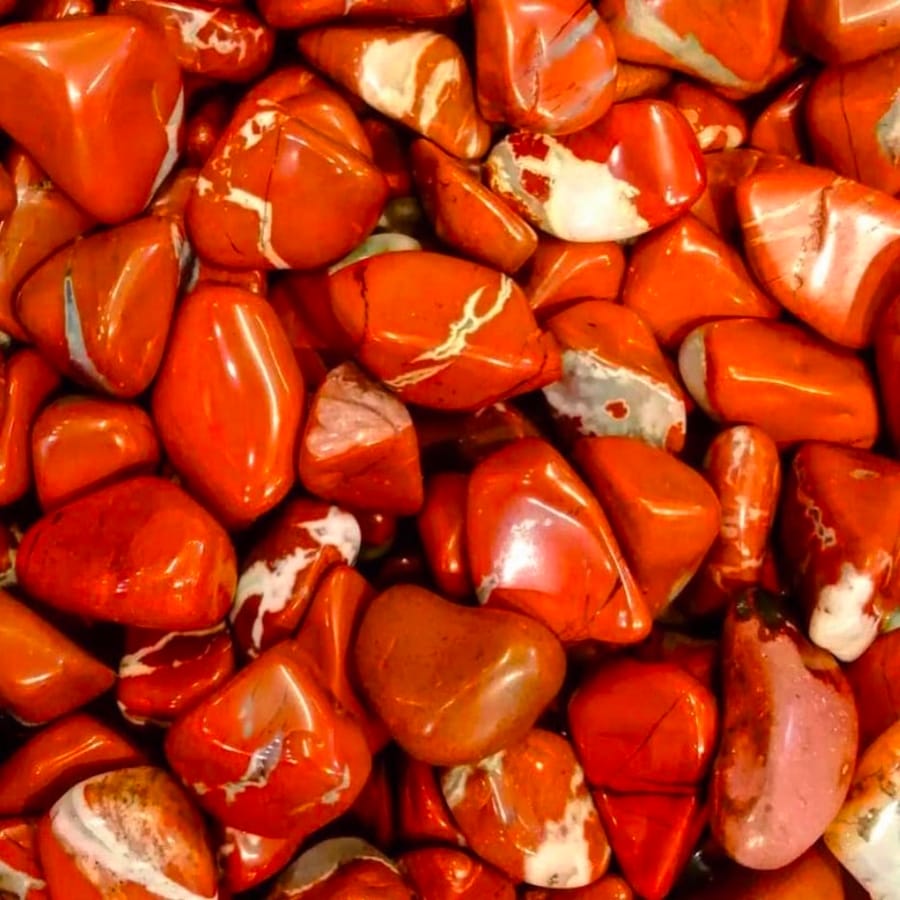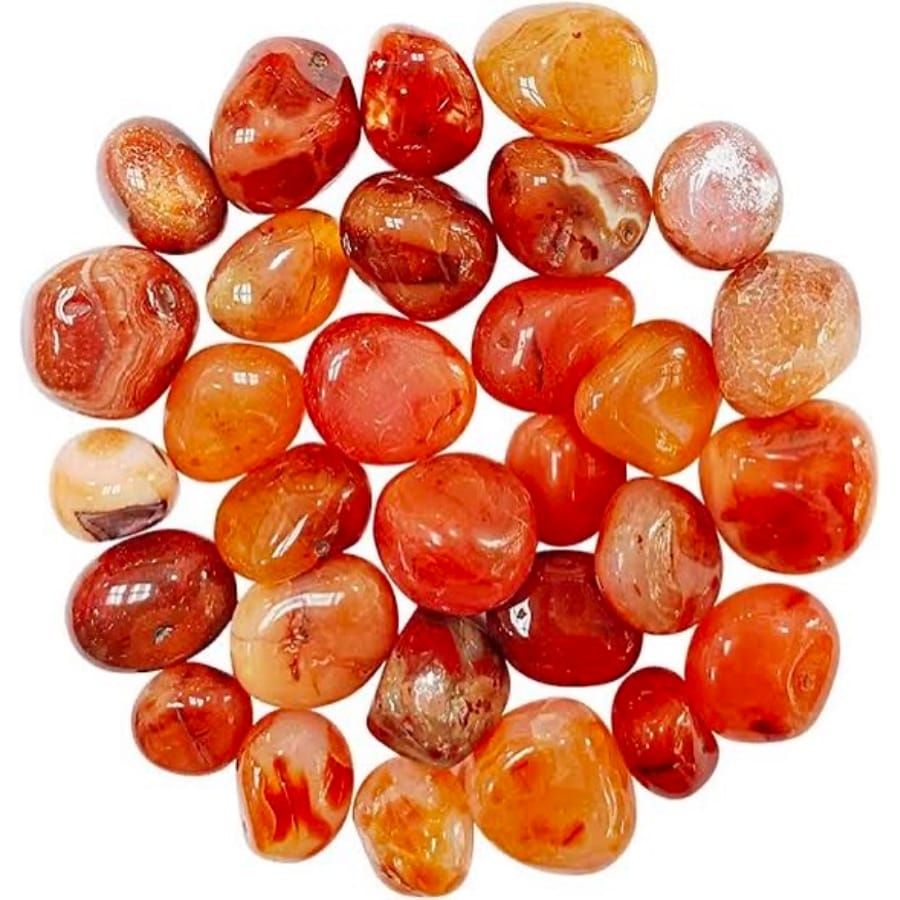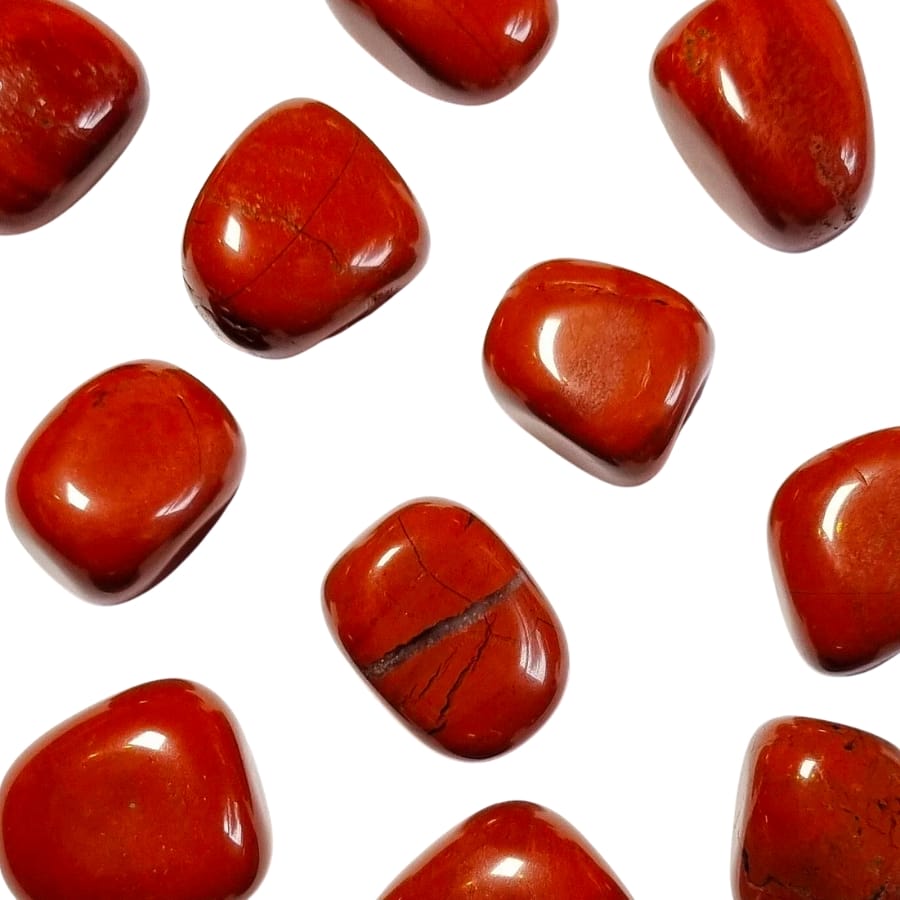Carnelian and red jasper have both captivated people for centuries, and their allure is as strong as ever. From their distinct appearances to their geological origins, there’s so much to discover about these gems.
To the untrained eye, they may look so much alike, so it will be important to know the differences between carnelian and red jasper. In this article, we’ll be exploring their unique characteristics and the similarities that they share.
These details on the comparison between carnelian vs jasper are not only interesting but also essential for understanding them and the uses of their individual properties in various applications.
Get ready as we demystify these two natural wonders and get to know each of them beyond what meets your eyes.
Carnelian vs Red Jasper – The Major Differences
If you don’t know their unique characteristics that go beyond how they look, it can be easy to mistake carnelian for red jasper and vice versa. But did you know that these two have a fair share of differences between them?
Color – Red jasper has a deep red color

With its diverse spectrum of colors, carnelian is often described as a fiery gem. You can find it in shades of vibrant orange, intense red, and even softer hues like pale peach and brownish-red.
The colors of carnelian are a result of trace amounts of iron oxide (Fe2O3) and other impurities within it. These impurities give it its warm and inviting appearance, reminiscent of a glowing sunset or a ripe fruit.
On the other hand, red jasper lives up to its name with a predominantly deep red color. It tends to have a consistent and rich reddish hue, occasionally featuring subtle variations, like streaks or patterns in black or brown.
The striking red tone of red jasper is also attributed to iron oxide, but in this case, the concentration and distribution of impurities create a more earthy and grounded appearance, akin to the deep soils of a fertile landscape.
Luster – Carnelian has a glassy luster

Luster refers to the way light interacts with the surface of a mineral or gemstone, and it plays a crucial role in defining its visual appeal.
Carnelian exhibits a distinctive glassy or vitreous luster with its smooth and polished appearance. When you hold a piece of it, you’ll notice how it reflects light, creating a shiny, almost translucent quality.
This glassy luster gives carnelian a lively and radiant appearance, enhancing its overall appeal and making it a favored choice for jewelry and ornaments.
In contrast, red jasper showcases a completely different luster. It typically possesses a matte or dull luster, lacking the shine and reflective qualities of carnelian.
When you examine one, you’ll notice that it doesn’t glisten or sparkle. Instead, it has a grounded and more subdued appearance, almost as if it’s been naturally weathered by the elements. This matte luster aligns with its earthy and rustic charm.
Hardness – Red jasper is more resistant to scratching

Hardness is a crucial property among gemstones because it determines how resistant they are to scratching and abrasion.
Carnelian, while a beautiful gem, is relatively softer on the Mohs scale of mineral hardness, typically falling within the range of 6 to 7. It can be scratched by harder materials, such as quartz or topaz.
While it’s durable enough for everyday wear in jewelry, it requires some care to prevent surface damage and scratches over time. Its somewhat lower hardness is a trade-off for its vibrant colors and translucency.
On the other hand, red jasper boasts a higher level of hardness, typically ranking at 7 on the Mohs scale. This makes it more resistant to scratching and abrasion compared to carnelian.
Its increased hardness can be attributed to its denser composition, which consists of fine-grained quartz and other minerals. As a result, red jasper is better suited for jewelry pieces that may be exposed to more wear and tear.
Density – Carnelian feels lighter in the hand

Density is a measure of how tightly packed the particles are in a substance and is often expressed in grams per cubic centimeter (g/cm³). It can reveal valuable information about a gem’s composition and overall characteristics.
Carnelian typically has a lower density compared to red jasper. Its exact density can vary depending on factors such as impurities and porosity, but it generally falls within the range of 2.58 to 2.64 g/cm³.
In contrast, red jasper is known for its higher density. It typically ranges from 2.61 to 2.65 g/cm³. This is due to its denser composition, which includes fine-grained quartz and other minerals.
When you hold a piece of red jasper, it often feels more substantial and weighty compared to carnelian.
Location – Red jasper has well-known deposits in Australia

Carnelian is sourced from various locations around the world. Some of its notable deposits include India, where it has been used for centuries in jewelry and ornamental objects. Brazil is also known for its high-quality specimens.
You can also find it in Uruguay, Madagascar, and the U.S., particularly in Oregon. If you want to know where to find carnelian, check out our article on that. You can also visit our guide to finding gems near you if you need more help.
Meanwhile, red jasper is also found in several locations across the globe. Australia is a well-known source, where it can be found in the rugged landscapes of Western Australia and other regions.
Brazil, India, and the U.S. also yield it, with deposits in Arizona and Montana. Should you be planning on finding it, check out our guide to finding jasper, too.
Price – Carnelian can fetch higher prices

The cost of gemstones can vary widely based on several factors, and carnelian and red jasper are no exceptions.
With its stunning array of colors and its historical significance in jewelry and art, carnelian tends to be relatively more expensive than red jasper. Its vibrant shades, especially the deep red and fiery orange varieties, make it highly sought after for use in rings, necklaces, and other jewelry pieces.
Additionally, its translucent quality and the skill required for its lapidary work contribute to its higher price tag. The presence of intricate patterns or rare color variations can further increase the value of carnelian.
On the other hand, red jasper’s earthy, rustic appearance, while beautiful in its own right, doesn’t command the same premium prices as carnelian. It’s commonly used for decorative items, carvings, and larger ornamental pieces.
While high-quality specimens with exceptional patterns can still fetch a good price, in general, red jasper’s price tends to be more budget-friendly.
Carnelian vs Red Jasper – The Similarities
If you’re having a hard time telling between carnelian and red jasper, you don’t need to feel bad because they do share a lot of similarities. In fact, they are more alike than they are different, as you’ll understand in our next discussion.
Crystal Structure – Red jasper and carnelian both lack a distinct crystal structure

The crystal structure of a mineral or gemstone is a fundamental aspect that defines its physical properties and appearance.
Both carnelian and red jasper belong to the chalcedony group of minerals, which means they share a similar microcrystalline structure. In this structure, the individual crystals are too tiny to be seen with the naked eye, giving the stones their smooth and sometimes waxy appearance.
Instead of forming distinct and well-defined crystals, chalcedony minerals like carnelian and red jasper consist of interlocking microscopic crystals that create a dense, solid mass.
This lack of prominent crystal structure is one of the reasons they are highly prized for their smooth and polished appearance. Instead of sharp edges and facets, carnelian and red jasper often have a uniform and fine-grained texture.
Cleavage – Both carnelian and red jasper exhibit no cleavage

Cleavage refers to how minerals break along specific planes or directions when subjected to force. Knowing a gem’s cleavage sheds light on its durability and resilience.
Both carnelian and red jasper exhibit no cleavage. This means that when force is applied to these gemstones, they do not break along distinct planes or directions like some other minerals.
Instead, they fracture in an irregular and often conchoidal manner. This type of fracture results in curved, shell-like surfaces with no specific pattern of breakage.
This absence of cleavage makes them relatively tough and resistant to easy splitting or breaking. This is a desirable quality for gemstones used in jewelry and ornamental pieces, as it means they can withstand everyday wear and tear.
Composition – Red jasper and carnelian are both primarily composed of silicon dioxide

Carnelian and red jasper share a significant similarity in their chemical composition. Both of them are primarily composed of silicon dioxide (SiO2), which is essentially quartz.
Silicon dioxide is a crystal lattice made up of silicon (Si) and oxygen (O) atoms. In its pure form, quartz is colorless and transparent. However, it’s the presence of trace elements and impurities that give carnelian and red jasper their distinct colors and variations.
The common impurity that significantly influences the appearance of both gemstones is iron oxide (Fe2O3). Iron oxide imparts the warm and rich hues seen in these gemstones.
In carnelian, it results in shades of vibrant orange, red, and brown, while in red jasper, it creates the deep and earthy red tones that are characteristic of the stone.
Formation – Both carnelian and red jasper form in sedimentary environments

Both carnelian and red jasper are typically formed in sedimentary environments. These are settings where sediments like clay, silt, and organic materials accumulate and eventually harden into rock.
In the case of these two, the primary host rocks are often silica-rich materials like chert, limestone, or shale. Their formation begins when silica-rich waters percolate through the host rocks. These waters carry dissolved silica (SiO2) and trace elements, including iron (Fe), which impart their distinctive colors.
Over time, as the silica-rich solutions saturate the host rock’s pores and cavities, they gradually deposit layers of silica within these spaces. These layers build up and, over countless years, crystallize to form carnelian and red jasper.
The specific colors and patterns seen in carnelian and red jasper result from variations in mineral content, temperature, pressure, and the length of time these processes occur.
Streak – Both red jasper and carnelian leave white streaks

In both carnelian and red jasper, the streak color is generally white. When you rub a piece of these two gems against a porcelain plate, it leaves behind a white streak, indicating that the color of the mineral’s powder is pale or colorless.
This similarity in streak color is due to the fact that both are primarily composed of silicon dioxide (SiO2), which is a mineral with a colorless or white streak.
While the distinctive red and orange hues of these gemstones are caused by trace amounts of iron oxide (Fe2O3) and other impurities, these impurities are not present in high enough concentrations to alter the streak color significantly.
Magnetism – Carnelian and red jasper are both non-magnetic

When a mineral is non-magnetic, it means that it does not exhibit any magnetic attraction or repulsion when subjected to a magnetic field.
In the case of carnelian and red jasper, you can place a strong magnet next to these gemstones, and they will not be attracted to or influenced by the magnetic field in any noticeable way.
The absence of magnetism in both of them is primarily due to their mineral composition. Silicon dioxide is a non-magnetic mineral.
While they may contain trace amounts of other elements and impurities like iron, these are not present in concentrations high enough to confer magnetic properties to the stones.
This non-magnetic quality makes carnelian and red jasper well-suited for various uses in jewelry and decorative items where their stunning colors and patterns take center stage without any interference from magnetic forces.
Fluorescence – Both red jasper and carnelian are non-fluorescent

Fluorescence refers to the emission of visible light when a substance is exposed to ultraviolet (UV) radiation, commonly found in black lights.
When subjected to UV light, carnelian and red jasper do not exhibit fluorescence. They do not emit visible light in response to UV radiation. Instead, they typically remain inert under UV light, without any noticeable glow or color change.
Like their other shared properties, the lack of fluorescence is due to the silicon dioxide in them, which is known for its non-fluorescent nature.
Minerals and gemstones that do fluoresce often contain specific trace elements or defects in their crystal structures that enable them to emit visible light when exposed to UV radiation.
In contrast, carnelian and red jasper, with their non-fluorescent behavior, maintain their rich and earthy appearances regardless of the lighting conditions.
Conductivity – Carnelian and red jasper are both non-conductive

Electrical conductivity is a property that describes a material’s ability to conduct an electrical current, and it can vary widely among different minerals and gemstones.
Silicon dioxide, which is the main ingredient for both carnelian and red jasper, is a poor conductor of electricity. Its tight bonding restricts the movement of electrons, preventing the flow of electrical current.
This makes both of them non-conductors. This lack of electrical conductivity makes them suitable for various jewelry and decorative applications. It ensures that they can be safely worn without concerns about electrical interference.
Gemstones that are good conductors of electricity can pose challenges in jewelry settings, as they may interfere with electronic devices or create discomfort for wearers due to their conductivity.
The Easiest Ways To Tell Carnelian and Red Jasper Apart

Let’s say you have two specimens that you suspect are either carnelian or red jasper, how can tell which is which? Aside from carefully inspecting them based on their differences, you can also do the following simple tests:
Pay close attention to its color
While both can exhibit shades of red and orange, the nuances in their coloration offer valuable clues.
Carnelian, known for its vibrant and varied color palette, often showcases an array of hues, including fiery oranges, rich reds, and even paler shades like peach or brownish-red.
Red jasper, on the other hand, tends to have a more consistent and earthy red tone. Its colors are typically deeper and more subdued than those of carnelian. This uniformity in color can resemble the rich red soils of the Earth.
Look for bands and patterns
Both gemstones can display distinct visual characteristics in this regard, providing crucial clues for identification.
Carnelian often exhibits striking bands, swirls, and agate-like patterns within its structure. These banding patterns result from variations in the distribution of impurities and minerals during its formation.
Red jasper, in contrast, typically displays fewer banding patterns. While it may have some minor variations or inclusions, it generally features more uniform and solid coloration. This visual consistency contributes to its earthy appearance.
Examine its luster and surface texture closely
Carnelian typically displays a glassy or vitreous luster. When you hold a piece of it, you’ll notice how it reflects light, creating a shiny and almost translucent quality. This glassy luster gives carnelian a lively and radiant appearance.
In contrast, red jasper showcases a matte or dull luster, lacking the shine and reflective qualities seen in carnelian. It doesn’t glisten or sparkle. Instead, it has a more subdued appearance, which aligns with its earthy and rustic charm.

